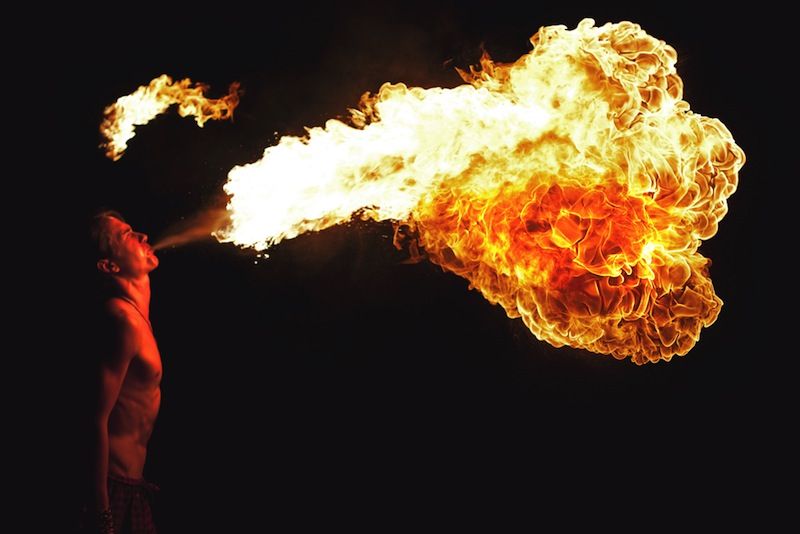Fire Breather Gets Pneumonia From Ingesting Fuel

A novice fire breather in Europe ended up in the emergency room with pneumonia after he inhaled and swallowed and a chemical called paraffin during a performance, according to a new report of his case.
The patient, a 25-year-old student in the Republic of Macedonia, tried to perform a fire-breathing show without any previous experience. He put some paraffin oil, a common fuel used by fire breathers, in his mouth and tried to blow it into a pillar of fire, but he accidently swallowed and inhaled a small amount of the oil.
The doctors at the hospital where he was admitted in October 2010 diagnosed the man with acute aspiration pneumonia, less formally known as "fire-breathing" pneumonia. The symptoms include serious breathing problems and pain.
After four weeks of treatment, the patient had recovered completely, and left the clinic.
"Our patient, due to the urgent diagnosis and proper treatment, did not suffer from chronic complications," said study author Dr. Andon Chibishev, of the University Clinic of Toxicology and Urgent Internal Medicine in the Republic of Macedonia.
Chibishev told Live Science that he had recently talked to this patient, and the man said he was trying to find a new occupation. The patient "definitely left the job as an amateur fire breather," Chibishev said. [16 Oddest Medical Cases]
The fire breather did not develop any symptoms immediately following the incident. Rather, about two days later, he felt mild pain in his abdomen and severe pain in his chest.
Sign up for the Live Science daily newsletter now
Get the world’s most fascinating discoveries delivered straight to your inbox.
When he arrived at the ER, he had a fever. He also said he was having headaches, dizziness, persistent dry cough and difficulty breathing, and was spitting blood.
The patient was admitted to the clinic, and for the next three days, his symptoms became more severe "and he was in a very critical condition," the researchers wrote in the study.
The patient received corticosteroids (anti-inflammatory steroids) for more than two weeks. After 10 days, his condition started to improve slightly. On day 17, he was determined to be in a good condition and was transferred to a regular ward, where the doctors continued to treat him with intravenous fluids and vitamins, according to the report.
After the patient left the clinic, the doctors continued to monitor him because of the seriousness of his condition. Three months later, he was in excellent condition, they said.
To produce a pillar of fire, performers use fuel and a flame source, the researchers wrote in the study. "Controlling the fuel's direction and consistency is a technique that requires a lot of time to improve," they wrote. Fire breathers may use different chemical substances as fuel, but liquid paraffin is a frequent choice, they added.
It is not clear how common paraffin intoxication is among fire breathers, but the researchers suspect it is rare, Chibishev said, acknowledging that this suspicion is based on the investigators' minimal experience in studying this particular topic.
The researchers cited a previously described similar case of a fire breather's aspiration pneumonia in Italy, in which a 29-year-old person developed fever, shortness of breath, cough and chest pain. The most severe phase of the intoxication lasted four weeks, and the patient recovered completely within three months, according to a report of the case, published in April 2006 in the Italian Journal of Occupational Medicine and Ergonomics.
Some of the potential and most dangerous complications of paraffin intoxication include fatal pneumonias, excessive buildup of fluid around the lungs that may impair breathing, acute respiratory distress syndrome (a life-threatening condition in which the respiratory system fails suddenly) and upper gastrointestinal bleeding. There is also a risk of developing small holes or tears in the digestive system, which may occur when a person both inhales and swallows the fuel, Chibishev said.
Though they're very rare, some of the complications can be fatal, he said.
Follow Agata Blaszczak-Boxe on Twitter. Follow Live Science @livescience, Facebook & Google+. Originally published on Live Science.













